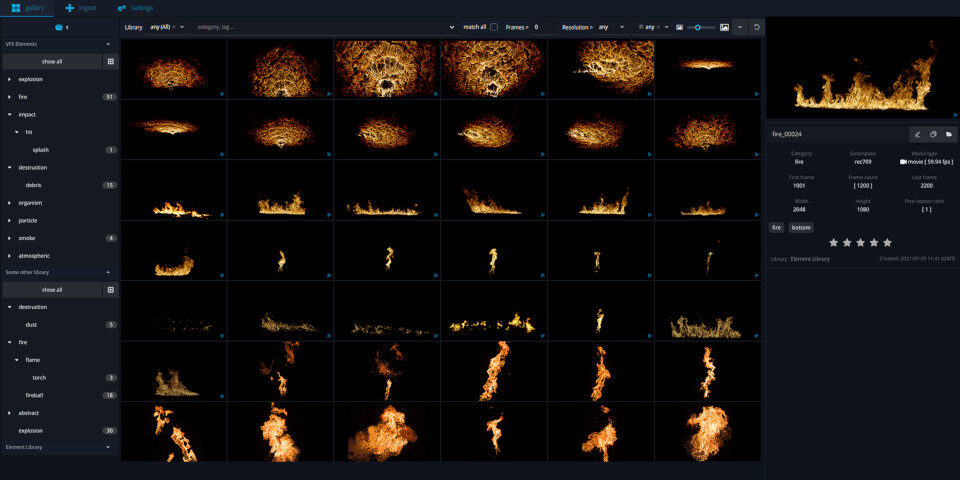Das Element uses AI to sort your VFX asset library
Originally posted on 4 August 2021. Scroll down for news of the Das Element 2.0 update.
Das Element has released Das Element, its self-titled new AI-based application for organising libraries of assets for visual effects work, like images, sequences and stock effects clips.
The application, which runs entirely offline, uses a VFX-specific machine learning model to automatically generate tags for new elements ingested into a studio’s library.
Its developer, former Scanline VFX editor Jonas Kluger, describes it as “a simple and easy way to organise the ‘chaos folder’ that probably every company has somewhere on the server”.
Turn large sets of 2D assets into an ordered VFX library
Das Element – strictly, it’s ‘das element’ without the capital letters – is designed to organise large sets of 2D assets: source images, stock effects clips, rendered image sequences, and the like.
Users can browse the contents of the library by thumbnail previews and filter them via keyword tags.
The application uses a tag hierarchy tailored towards VFX work: for example, fire effects elements are sorted using the hierarchical structure fire > flame > torch.
Other notable features include the option to define file naming conventions and library folder structures by dragging and dropping name elements around in a visual interface.
The software also makes it possible to set up templates for transcoding files automatically: a feature used internally to generate thumbnails and previews for an asset library.
Use machine learning to generate tags for new assets automatically
As well as tagging new assets manually, users can have Das Element generate tags automatically, using a machine learning model “specifically designed for VFX and trained on thousands of VFX elements”.
A second model generates tag suggestions based on the assets you have previously added to the library.
According to the online FAQs, the results need double-checking by a human user, but “the number of categories … will constantly increase and the model will get better over time”.
Unlike Turbo Squid’s Kraken Pro, which also uses a machine learning model to organise asset libraries, Das Element runs entirely offline, making it easier to keep data secure.
The software also has a command-line edition, which can be run on a renderfarm, automatically tagging shots as they are rendered.

Updated 15 March 2022: Das Element has released Das Element 1.1.4.
The update adds support for a wider range of file types, with users now able to use the software to organise After Effects projects, Nuke templates, Illustrator and InDesign files, and PDFs: for example, camera reports.
Other changes include a new system for generating more meaningful thumbnails for file sequences and videos that automatically grabs a representative frame for the asset; and a new ratings system for assets.
Updated 2 August 2022: Das Element has released Das Element 1.2.
The update adds the option for grouping assets into ‘Collections‘ – smaller sets of elements that fit a shot or sequence – that can be shared with other team members.
Users can also export sets of assets from Das Element to view the hi-res versions in other applications, like compositing packages or external media players, via a rather confusingly named ‘shopping cart’.
Other changes include a new sphere asset type for viewing and managing panoramic HDRIs.
Released 13 November 2023: Das Element has released Das Element 2.0.
The update adds support for 3D assets, with users able to preview 3D models inside the software, and associate them with assets like textures.
There is also a new AI-based feature to identify and display visually similar assets.
Suggested use cases include both identifying new source assets for a project, and simply identifying files that have been duplicated across multiple locations on a studio’s network.
Das Element’s UI has also been reworked, with the gallery view now scrolling endlessly when browsing assets.
There is also a new exposure slider when previewing HDRI images or 360-degree videos, and the software’s video player now provides options to flip video or change playback speed.
Pricing and system requirements
Das Element 2.0 is available for 64-bit Windows 10+, CentOS/Debian Linux and macOS.
The software is rental-only. Floating GUI licences cost €499/year (around $540/year) and floating command line licences cost €399/year ($430/year).
Lite licences, which let you browse the library but not tag assets, cost €49/year.
